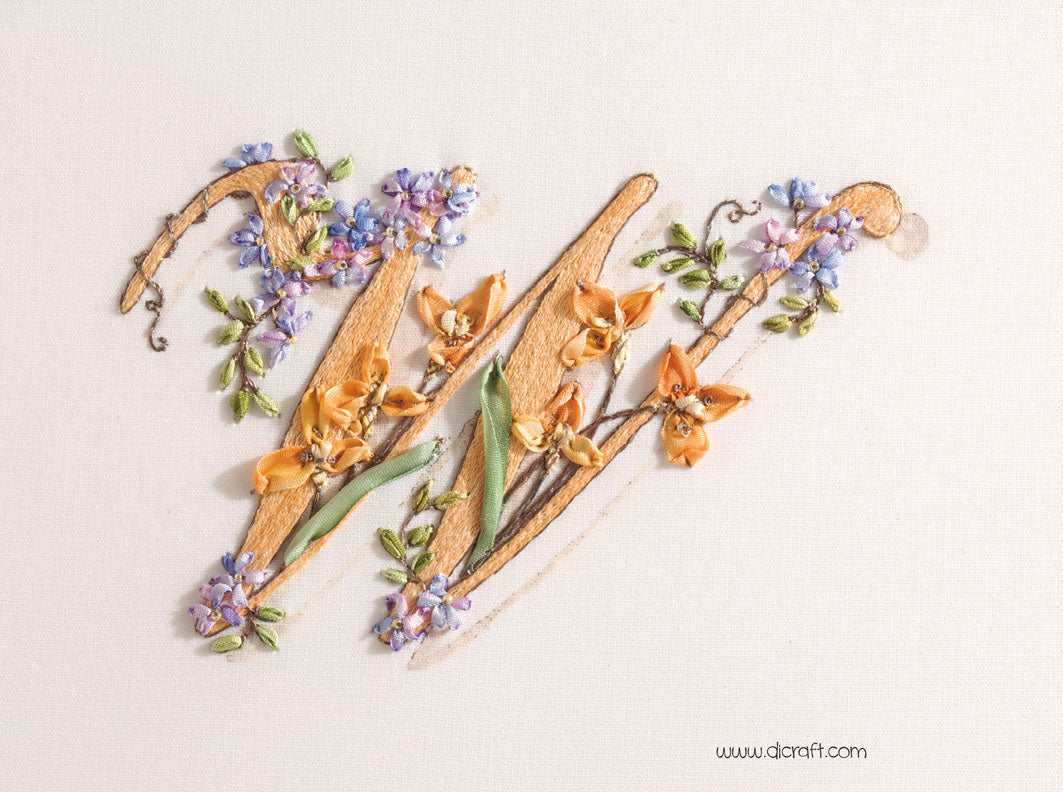A free tutorial: How to Make a Monogram – The Letter W Hello, stitching world •*¨*•♫♪. I hope you are having a good day today. Do you have the letter W in your name or does a special person in your life have a name that starts with a W?This is from me to you for World Embroidery Day on 30 July! Enjoy!  This monogram is on pages 104 and 105 of my book:Embroidered Alphabets and Monograms & Words Note:
This monogram is on pages 104 and 105 of my book:Embroidered Alphabets and Monograms & Words Note: This book is out of print (we have no copies left) as far as I know, it's out of print almost everywhere. So if you can, get a copy soon!
You can download the pattern for your collection
here. Here's how to make the W monogram...
 METHOD A list of what you needThreads*six-strand thread. Separate and use one strand out of the six.
METHOD A list of what you needThreads*six-strand thread. Separate and use one strand out of the six.  a) Gumnut "Stars" pure silk no. 784
a) Gumnut "Stars" pure silk no. 784 b) Chameleon stranded silk no. 111 Silk Ribbons
b) Chameleon stranded silk no. 111 Silk Ribbons 1) Di van Niekerk’s 2mm silk no. 35
1) Di van Niekerk’s 2mm silk no. 35 2) Di van Niekerk’s 2mm silk no. 81
2) Di van Niekerk’s 2mm silk no. 81 3) Di van Niekerk's 2mm silk no. 109
3) Di van Niekerk's 2mm silk no. 109 4) Di van Niekerk's 7mm silk no. 57
4) Di van Niekerk's 7mm silk no. 57 5) Di van Niekerk's 7mm silk no. 16 Needles
5) Di van Niekerk's 7mm silk no. 16 Needles  Crewel size 9 or 10Chenille size 18 and 22Tapestry size 18Crewel size 10 or straw size 9 for beading NOTES: I have uploaded the design to my website for you to download here:[download id="195"]
Crewel size 9 or 10Chenille size 18 and 22Tapestry size 18Crewel size 10 or straw size 9 for beading NOTES: I have uploaded the design to my website for you to download here:[download id="195"] * Note: The PDF file is 3,71 MB in size for you to have a good-quality picture to print.Due to the size, it may take a while to appear on your screen and to download and save.Print the design and refer to: How to copy and print the image onto fabric on page 16 to 22 in the book.* For a quick and easy option, you are welcome to order the panel, ribbon and threads here (choose from the W options). What else do you need?
* Note: The PDF file is 3,71 MB in size for you to have a good-quality picture to print.Due to the size, it may take a while to appear on your screen and to download and save.Print the design and refer to: How to copy and print the image onto fabric on page 16 to 22 in the book.* For a quick and easy option, you are welcome to order the panel, ribbon and threads here (choose from the W options). What else do you need? The printed or traced panel with the design. See notes above.Backing fabric—the same size as your embroidery panel. Read more about backing fabric on page 23.10 inch (25 cm) hoop Stitches used in this design
The printed or traced panel with the design. See notes above.Backing fabric—the same size as your embroidery panel. Read more about backing fabric on page 23.10 inch (25 cm) hoop Stitches used in this design  * See stitch gallery on pages 52 to 58 of the book and I have also added the links to the stitch blog with the step-by-step instructions that follow.Backstitch, Detached Chain stitch, French knot, Grab stitch, Ribbon stitch, Stab stitch, Stem stitch filling, Stem stitch, Straight stitch, Twisted ribbon stitch, Twisted straight stitchNote: use one strand of thread unless suggested otherwise.* If you have the book, you could also refer to:
* See stitch gallery on pages 52 to 58 of the book and I have also added the links to the stitch blog with the step-by-step instructions that follow.Backstitch, Detached Chain stitch, French knot, Grab stitch, Ribbon stitch, Stab stitch, Stem stitch filling, Stem stitch, Straight stitch, Twisted ribbon stitch, Twisted straight stitchNote: use one strand of thread unless suggested otherwise.* If you have the book, you could also refer to: - Before You Start on pages 23-28
- Keeping your work clean and Useful Hints on page 29
- Stitches and Techniques on pages 31-49
Step-by-step instructionsClick on the images to enlarge
 1. Fill in the initial
1. Fill in the initial With thread a, fill in the initial with stem stitch.
With thread a, fill in the initial with stem stitch.  Make rows of stem stitch close together, filling in the shape with row after row of stem-stitch, making them close together for a neat finish. See stem-stitch filling below.
Make rows of stem stitch close together, filling in the shape with row after row of stem-stitch, making them close together for a neat finish. See stem-stitch filling below.  Note: make short stitches when you reach the curved part of the shape.
Note: make short stitches when you reach the curved part of the shape.  Fill in any gaps between the stem stitches with straight stitch. With thread b, make a row of stem stitch along the edge of the initial to create a dark shadow and to neaten the edge at the same time.
Fill in any gaps between the stem stitches with straight stitch. With thread b, make a row of stem stitch along the edge of the initial to create a dark shadow and to neaten the edge at the same time.  2. Make the stems Use thread b and with stem or backstitch, make the brown twirled stems of the daisies. For a neat finish, make short stitches to accommodate the curves.Use two or three rows of stem stitch, formed close together, for the upright stems of the orange lilies. 3. Make the daisies and leaves
2. Make the stems Use thread b and with stem or backstitch, make the brown twirled stems of the daisies. For a neat finish, make short stitches to accommodate the curves.Use two or three rows of stem stitch, formed close together, for the upright stems of the orange lilies. 3. Make the daisies and leaves  Use the green ribbon 1 and make detached chain stitches to make the small leaves of the lavender-blue daisies.With thread b, use a grab stitch at the base of each leaf to form a neat, narrow leaf. Insert the needle further away from the shape to create a short, slender stalk.
Use the green ribbon 1 and make detached chain stitches to make the small leaves of the lavender-blue daisies.With thread b, use a grab stitch at the base of each leaf to form a neat, narrow leaf. Insert the needle further away from the shape to create a short, slender stalk.
 Use the lavender ribbon 2 and make ribbon or straight stitches for the daisy petals. Work over a spare tapestry needle so the petals are slightly raised off the surface of the design. Use thread a or b to add a little yellow bead in the centre of each lavender-blue daisy. 4. Make the orange lilies
Use the lavender ribbon 2 and make ribbon or straight stitches for the daisy petals. Work over a spare tapestry needle so the petals are slightly raised off the surface of the design. Use thread a or b to add a little yellow bead in the centre of each lavender-blue daisy. 4. Make the orange lilies  Use ribbon 3 and make three or four straight stitches (formed at an angle) to make the trumpet part of the lily. Work from the stem upwards. Use thread b and make two or three straight stitches on top of the ribbon to create the dark shadows.
Use ribbon 3 and make three or four straight stitches (formed at an angle) to make the trumpet part of the lily. Work from the stem upwards. Use thread b and make two or three straight stitches on top of the ribbon to create the dark shadows.  Change to ribbon 4 and make the orange petals in ribbon stitch, working from the centre outwards and stitching over a spare tapestry needle so the stitches are raised off the surface of the fabric.
Change to ribbon 4 and make the orange petals in ribbon stitch, working from the centre outwards and stitching over a spare tapestry needle so the stitches are raised off the surface of the fabric.  Use thread b and make tiny straight/stab stitches to form the brown spots on the petals.Use the same thread and stitch to form the brown tips of the petals. Use ribbon 3 and make two straight stitches to form the yellow stamens in the centre of each lily. Change to thread b and use two-wrap French knots to add more brown spots on the petals. Make the dark shadows between the stamens (in the centre of the lily) with tiny straight/stab stitches.5. Make the lily leaves
Use thread b and make tiny straight/stab stitches to form the brown spots on the petals.Use the same thread and stitch to form the brown tips of the petals. Use ribbon 3 and make two straight stitches to form the yellow stamens in the centre of each lily. Change to thread b and use two-wrap French knots to add more brown spots on the petals. Make the dark shadows between the stamens (in the centre of the lily) with tiny straight/stab stitches.5. Make the lily leaves  Change to ribbon 5 and with twisted straight stitch or twisted ribbon stitch, form the large green leaves.
Change to ribbon 5 and with twisted straight stitch or twisted ribbon stitch, form the large green leaves.
 Use thread b and make a few straight/stab stitches at the tip of the leaf and add another stitch or two on the base of the leaf to secure the ribbon and to prevent it from pulling out of shape.Folding the ribbon in half with your index finger, use a tiny straight/stab stitch or two along the edge of the ribbon to hold the shape of the leaf. And the completed piece...
Use thread b and make a few straight/stab stitches at the tip of the leaf and add another stitch or two on the base of the leaf to secure the ribbon and to prevent it from pulling out of shape.Folding the ribbon in half with your index finger, use a tiny straight/stab stitch or two along the edge of the ribbon to hold the shape of the leaf. And the completed piece... I hope that you enjoyed this tutorial ♥ I have some beautiful masterpieces to share with you in the weeks to come.
I hope that you enjoyed this tutorial ♥ I have some beautiful masterpieces to share with you in the weeks to come. - Subscribe to Di van Niekerk and receive email updates as soon as I post a new blog.
- You are also welcome to join me and many other talented embroiderers on Facebook.
-
….and stay in touch with the latest on Instagram
Enjoy and have a Wonderful Weekend! LoveDi
































Leave a comment